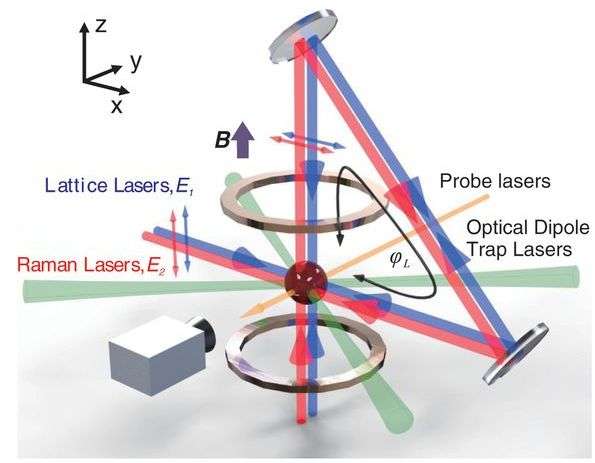October 7, 2016 report
Researchers demonstrate a single laser source scheme for studying topological matter in cold-atom systems

(Phys.org)—A team of researchers with members from several institutions in China has developed a new means for studying topological matter in cold-atom systems that involves using a single laser source. In their paper published in the journal Science, the team describes how the scheme works and outlines possible uses for it. Monika Aidelsburger with UPMC Sorbonne University offers an overview of the work done by the team in a Perspective piece in the same journal issue and offers some insight into some of the possible directions such research is going.
Research regarding topological matter in cold-atom systems has contributed insights into such systems due to the degree of controllability it offers in simulating condensed matter models—interesting topological phenomena have been observed recently in condensed-matter systems. But at the same time, many have found it rough going due to the tricky nature of dealing with the spin-orbit coupling that is involved. In this new effort, the researchers have come up with an approach that is easier to carry out, and as a bonus, it can be tuned between dimensions of the spin orbit.
Conventional methods have relied on having the role of spin carried out by certain states of an atom, while the coupling has been caused to come about using the light from a laser—most have resorted to actually using two laser beams to achieve hyperfine levels through a Raman transition. To make the process easier, the researchers used a single laser beam, which they split into two parts, allowing for the creation of an optical lattice that was spin-independent, and a Raman beam that was frequency shifted—allowing for a double Raman transition in two dimensions to cause spinflips. This setup makes the work less difficult and offers another advantage—the dimensionality is tunable between one and two dimensions.

The researchers note that while they used bosonic atoms, they believe the scheme would work equally well with fermions, and suggest that because their two-dimensional spin-orbit coupling system is more topological stable, it could offer new research opportunities for those studying unusual quantum phases such as topological superfluids.

More information: Z. Wu et al. Realization of two-dimensional spin-orbit coupling for Bose-Einstein condensates, Science (2016). DOI: 10.1126/science.aaf6689
Abstract
Cold atoms with laser-induced spin-orbit (SO) interactions provide a platform to explore quantum physics beyond natural conditions of solids. Here we propose and experimentally realize two-dimensional (2D) SO coupling and topological bands for a rubidium-87 degenerate gas through an optical Raman lattice, without phase-locking or fine-tuning of optical potentials. A controllable crossover between 2D and 1D SO couplings is studied, and the SO effects and nontrivial band topology are observed by measuring the atomic cloud distribution and spin texture in momentum space. Our realization of 2D SO coupling with advantages of small heating and topological stability opens a broad avenue in cold atoms to study exotic quantum phases, including topological superfluids.
Journal information: Science
© 2016 Phys.org




















